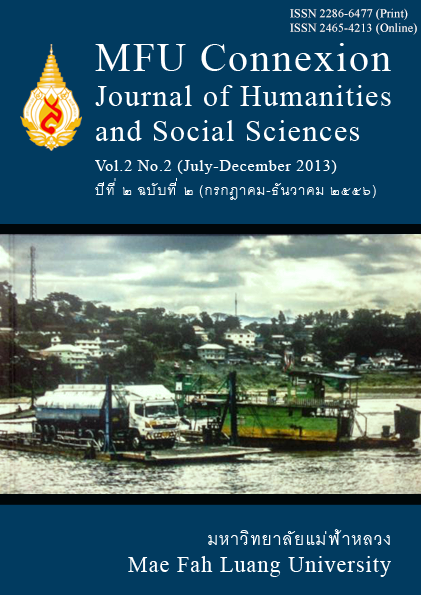ปัจจัยชี้วัดคุณภาพชีวิตของประชาชนในเขตควบคุมมลพิษของประเทศไทย
Main Article Content
Abstract
The purpose of this research is to study the key factors which indicate quality of life of population in pollution control area in Thailand. This study was qualitative research by collecting data from 3 areas: Had Yai District in Songkhla Province, Samut Sakhon Province and Ban Laem District in Phetchaburi Province. The research was conducted by focus group discussion which is classified to be 6 inhabitants groups and 6 community leaders groups. Then, gather information from academic documentary which is related to life quality and life quality evaluation elements. From the study findings, it is found that the total aspects of quality of life of population in pollution control area are 26 in number which are consisted of 5 factors: Residence, Economic condition, Social condition, Environment condition, and Health and Sanitation. Factor which has the highest number of aspects is Environment condition (7 aspects) because the sampling area is the pollution control area; therefore, the sampling group paid attention and took the environmental factors into consideration much more than other factors. The second following factor is Health and Sanitation (6 aspects), Residence (5 aspects), Social condition (5 aspects), and Economic condition (3 aspects). The sampling group paid less attention to Economic condition than the other factors because there are number of factories in the area which offer employment and afford income for local people. So, to get the most suitable quality of life aspect, the assessment of quality of life aspect of local people in each area should be made in-depth regarding the quality of life aspect before beginning the assessment because each area has different physical characteristics and problematic conditions.
Article Details
Copyright
Connexion: Journal of Humanities and Social Sciences has an exclusive right to publish the accepted articles in any form. However, the author retains the following rights:
1. The right to the ownership of the article;
2. The right to use all or part of the article in his/her other works;
3. The right to re-produce the article for personal use or for use in the author’s organisation, in which case the author must obtain permission from Connexion: Journal of Humanities and Social Sciences;
4. The right to make copies of all or part of the work for educational use or for the author’s use in classroom teaching; and
5. The right to include the work (both the preprinted and printed versions) in an institutional repository.
References
กระทรวงการพัฒนาสังคมและความมั่นคงของมนุษย์. (2548) รายงานการศึกษาโครงการกำหนดตัวชี้วัดคุณภาพชีวิต, กรุงเทพฯ: สำนักมาตรฐานการพัฒนาสังคมและความมั่นคงของมนุษย์.
เกื้อ วงศ์บุญสิน. (2538) ประชากรกับการพัฒนา, กรุงเทพฯ: สำนักพิมพ์แห่งจุฬาลงกรณ์มหาวิทยาลัย.
กระทรวงทรัพยากรธรรมชาติและสิ่งแวดล้อม กรมควบคุมมลพิษ. (2555) ประกาศคณะกรรมการสิ่งแวดล้อมแห่งชาติ เรื่องกำหนดเขตควบคุมมลพิษ, จาก https://www.pcd.go.th/download/regulation.cfm?task=s6 [ค้นเมื่อ 5 ธันวาคม 2554]
กระทรวงเทคโนโลยีและการสื่อสาร สำนักงานสถิติแห่งชาติ. (2554) ดัชนีชี้วัดที่สำคัญของประชากรและที่อยู่อาศัย สำมะโนประชากรและเคหะ พ.ศ. 2533 และ พ.ศ. 2543 (ทั่วราชอาณาจักร), จาก https://service.nso.go.th/nso/data/data/datao5_3.pdf [ค้นเมื่อ 5 ธันวาคม 2554]
นิตยา ภู่แสนธนาสาร. (2548) กฎระเบียบทางสิ่งแวดล้อม, กรุงเทพฯ: ภาควิชาวิทยาศาสตร์สิ่งแวดล้อม คณะวิทยาศาสตร์ มหาวิทยาลัยรามคำแหง.
บุญสม หรรษาศิริพจน์. (2535) คุณภาพชีวิตและสิ่งแวดล้อม, กรุงเทพฯ: สำนักวิจัยสถาบันบัณฑิตพัฒนบริหารศาสตร์.
Berg, B. L. (2007) Qualitative research methods for the social sciences (6th ed.), Long Beach: California State University.
Campbell, A. (1976) Subjective measures of well-being, American Psychologist.
Sharma, R.C. (1988) The Meaning of Quality of Life, In R.C. Sharma, editor, Population, resource, environment and quality of life, New Delhi: Dhanpat Rai and Sons.
World Health Organization. (1993) WHOQOL study protocol. WHO.


